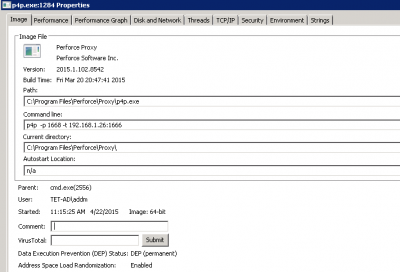Just my blog
Blog about everything, mostly about tech stuff I made. Here is the list of stuff I'm using at my blog. Feel free to ask me about implementations.
Soft I recommend
- Mobaxterm SSH RDP FTP...
- Thunderbird Email client
- Filezilla FTP client/server
- Nirsoft Win utils
- Sysinternals Win utils
- Pi-Hole AD block by DNS
- NUT UPS manager
- Rpi MON Raspberry monitoring
- Free CAD 3D modelling
- Free Commander Far-like filemanager
- Bitwarden Password manager
Py lib I recommend
- Django web framework
- celery multi-tasking
- celery-beat Celery + Django
- celery-results Celery + Django
- Pillow Python image lib
- wsgi mod Apache + Python
- requests best in WEB requests
- openpyxl make Excell docs
- p4python Perforce + Python
- paramiko SSH + Python
- pyvmomi ESXi Vcenter + Python
I'm using these libraries so you can ask me about them.
Installation Perforce Helix Proxy
Installation on Windows
Just using installer: Windows evidence:
C:\Program Files\Perforce\Proxy>p4p.exe -V Perforce - The Fast Software Configuration Management System. Copyright 1995-2015 Perforce Software. All rights reserved. This product includes software developed by the OpenSSL Project for use in the OpenSSL Toolkit (http://www.openssl.org/) See 'p4 help legal' for full OpenSSL license information Version of OpenSSL Libraries: OpenSSL 1.0.1l 15 Jan 2015 Rev. P4P/NTX64/2015.1/1028542 (2015/03/20).
And looks like there is nothing different with p4d.exe in logic. [su_spoiler title="p4p.exe -h"]
C:\Program Files\Perforce\Proxy>p4p.exe -h
Usage:
p4p [ options ]
Proxy options:
-d run as a daemon (fork first, then run)
-f run as single-threaded server
-i run for inetd (socket on stdin/stdout)
-q suppress startup messages
-c Do not compress proxy <-> server connection
General Options:
-h -? print this message
-V print server version
-r cache set proxy cache directory (default $P4PCACHE)
-v level debug modes (default $P4DEBUG)
-L log set error log (default $P4LOG, stderr)
-p port port proxy serves (default $P4PORT, 1666)
-t port port proxy uses to connect to a server
(default $P4TARGET, perforce:1666)
-e size proxy should only cache files larger than size
-u service Perforce user to authorize proxy
Proxy certificate handling options:
-Gc generate private key and certificate and quit
-Gf display the fingerprint of the public key and quit
Proxy monitoring options:
-l [-s] Show in-flight file requests to server (-s: summary)
-v lbr.stat.interval=N
Set the file status interval in seconds (default 10)
-v proxy.monitor.level=N
Set the proxy monitoring level:
0: monitoring disabled (default)
1: monitor file transfers only
2: monitor all operations
3: monitor all traffic for all operations
-v proxy.monitor.interval=N
Set the monitoring interval in seconds (default 10)
-mN Show currently-active connections and their status
(requires -vproxy.monitor.level >= 1)
The optional argument specifies the level of detail,
where -m1 shows less detail, and -m3 shows the most.
Proxy archive cache options:
-S Disable cache fault coordination
-vnet.maxfaultpub=N Set maximum size of coordinated cache faults
-vlbr.proxy.case=N Case folding:
1: file paths are always case-insensitive
2: file paths are insensitive if server is insensitive
3: file paths are never case-insensitive
When changing lbr.proxy.case, remove the existing
cache to ensure all cache contents obey the new
settings.
[/su_spoiler] As service:
C:\Program Files\Perforce\Proxy>p4p -p 1668 -t 192.168.1.26:1666 Perforce Proxy starting...
Installation on Centos
from guide: To install P4P on UNIX or Linux, do the following:
- Download the p4p executable to the machine on which you want to run the proxy.
- Select a directory on this machine (
P4PCACHE) in which to cache file revisions. - Select a port (
P4PORT) on which p4p will listen for requests from Perforce applications. - Select the target Perforce server (
P4TARGET) for which this proxy will cache.
And:
[root@testcentos www]# chmod u+x p4p
to start Proxy use this example:
p4p -p tcp64:[::]:1999 -t central:1666 -r /var/proxyroot
Starting:
[root@testcentos www]# ./p4p -p 1669 -t 192.168.1.31:1666 -r /var/www/proxyroot Perforce Proxy starting...
Started:
12851 root 11:06 ./p4p -p 1669 -t 192.168.1.31:1666 -r /var/www/proxyroot
tech
Tech posts, about installing or setting-up something.
raspberry
Everything related to raspberry
python
Using Python or coding in Python.
linux
Anything related to Linux user experience
octopus
Octopus is a framework for test execution, statistics collection and virtual machine deployment automation.
windows
WIndows OS and related issues and stuff.
REST
REST API for\from different services
Django
Django Web(Server) Framework
virtualization
Topics related to OS virtualization software
SQL DB
SQL type database and related issues
project man
Project management tools and thoughts, software and not.
web
Site hostings, web server, web browsing, web developing.
personal
Just personal thoughts, they aren't always readable or adequate
photo
My photos or photo related stuff.
